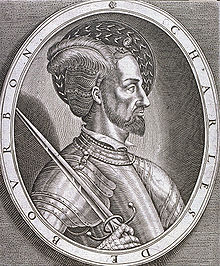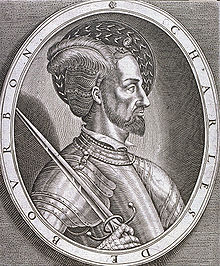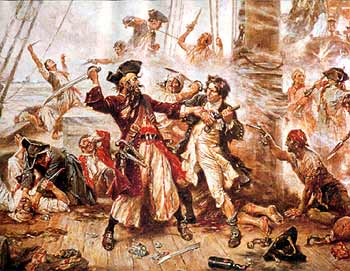The late Hollywood actor Errol Flynn may have been on to something. He made a career out of playing swashbuckling swordsmen in movies like “The Adventures of Robin Hood” and “Captain Blood”. These fictional men were handsome, conceited, vain, and adventurous, swaggering daredevils. But were there actual headstrong adventurers like this throughout history? And did they come to a good end? Here are a few examples of swashbuckling personalities in history.
Charles de Montpensier, Duke of Bourbon

Charles de Montpensier was a member of the cadet branch of the House of Bourbon, a prince of the royal blood in France. As a young man, he was chosen to marry his cousin Suzanne de Bourbon, the daughter of Anne de Beaujeu. Anne de Beaujeu was in turn the daughter of King Louis XI of France, known as the Spider King. King Louis admired his daughter so much that when he died, he named her as de facto regent for her young brother, King Charles VIII. When Anne’s tenure as regent ended, she managed to carve out of France a small kingdom for herself, the Duchy of Bourbon of which her husband was the heir.
Anne and her husband had no male children. They decided to marry their daughter Suzanne to Charles in an effort to merge the two branches of the Bourbon family. Charles joined the household of Anne as a teenager and she brought him up, teaching him the intricacies of government, politics and diplomacy. Anne did her best to ensure that Charles would inherit the Duchy of Bourbon as the undisputed heir so it would not be integrated into the Kingdom of France. Charles was at that point the head of the most senior branch of the House of Valois. If the Valois king of France had no male heirs, Charles or his heirs would succeed to the throne.
But things didn’t work out as planned after the deaths of Suzanne and Anne. Charles and Suzanne had no surviving children. Louise of Savoy, another pupil of Anne de Beaujeu and mother of King François I, sued Charles for his patrimony, arguing she had a better claim to the Duchy. Charles had a distinguished career in the Italian Wars and had been named made Constable of France by François. He had been rewarded for his role in the victory at the Battle of Marignano in 1515 and made Governor of Milan. But King François was wary of the proud and rich Duke of Bourbon and recalled him to France.
Charles resented being recalled and losing out to others for important commands. When Louise sued for his lands, she offered to settle the dispute by proposing Charles marry her but he refused. Being disgruntled with the turn of events, Charles made a secret agreement with the Holy Roman Emperor Charles V to betray his own king. A grand scheme was worked out between Bourbon, Charles V and King Henry VIII of England to partition France between themselves. However, the plot was discovered, Charles was divested of his patrimony and declared a traitor. He fled to Italy in 1523 and began serving as a military commander for Charles V.
Bourbon was in command of a combined Spanish-German army of about thirty five thousand that was sent to harass Pope Clement VII in Rome who was trying to shake off Imperial domination. However, Charles V didn’t feed or pay the troops. Bourbon was only able to keep the men unified by promising them unlimited loot. In May of 1527, despite a truce being declared between the pope and Charles V, Bourbon attacked Rome. He wore his customary white cloak to distinguish himself from his troops. But it also has the unintended consequence of marking him as their leader. As he was climbing a ladder up the walls of the city, he was shot in the chest and died.
All restraints were removed from the troops and the Sack of Rome lasted many months with the pope being held captive. Perhaps the most significant result of the Sack was that Pope Clement thought twice about issuing an annulment for the marriage of King Henry VIII of England to Katherine of Aragon. The delays caused Henry to break with the Catholic Church and declare himself head of the Church in England so he could marry Anne Boleyn.
Thomas Seymour, 1st Baron Seymour of Sudeley

Thomas Seymour was one of the siblings of Jane Seymour, the third wife of King Henry VIII of England. He was considered handsome and very ambitious. Jane’s son and Thomas’ nine year old nephew became King Edward VI upon the death of Henry VIII in January of 1547. According to Henry’s will, a council was to be appointed to rule during the minority of Edward VI. But Thomas’ elder brother Edward, Duke of Somerset was extremely ambitious and managed to get himself named Protector of the Realm, in effect de facto Regent and ruler of England.
While it had been the custom in the past for uncles to rule together during a king’s minority, Somerset made it clear Thomas would have no significant role in governing. As a consolation, Thomas was made Lord Admiral and 1st Baron Seymour of Sudeley but given no responsibilities. Thomas made a very rash secret marriage to Henry VIII’s widow, Katherine Parr without the consent of the council, putting him under suspicion. Thomas also managed to gain the guardianship of the king’s sister Princess Elizabeth and another important heir to the throne, Lady Jane Grey.
When Katherine Parr died in September of 1548, Thomas became one of the wealthiest men in England. Thomas may have conspired to marry the Princess Elizabeth himself. He also had plans to marry Lady Jane Grey to King Edward VI. As his relationship with his brother deteriorated, Thomas began to plot Somerset’s overthrow. The young king was kept a virtual prisoner with reduced resources and limited visitors. Thomas did his best to insinuate himself into the good graces of the king by giving him money. He also tried to convince Edward he didn’t need the Lord Protector to rule for him. At one point, he forced his way into King Edward’s bedchamber at night, with the unfortunate result of the king’s dog being killed. It is unclear why he did this but he may have been trying to gain custody of the king.
Thomas’ boundless ambition managed to get him into extreme trouble. He was arrested shortly after this incident and charged with treason about a month later. He was convicted and beheaded on Tower Hill on March 20, 1549.
Robert Devereux, 2nd Earl of Essex

Robert Devereux was a relative of Queen Elizabeth I through the Boleyn-Carey connection and he grew up as a ward of the Queen. He spent time as a young man in the household of William Cecil, Lord Burleigh and attended Cambridge, graduating with an MA. He was known to be exceedingly handsome and brilliant, wrote poetry and was masterly in the ways of courtly love. After his mother was widowed, she secretly married Robert Dudley, Earl of Leicester, the great favorite of Queen Elizabeth in 1578. In 1585, Robert’s mother convinced him to join Elizabeth’s court in London.
In December of 1585, Essex was granted permission by the Queen to accompany his stepfather and the English Army in their mission to aid the Dutch in their fight against the Spanish. He participated in some of the fighting and was made a knight by Leicester, releasing him from his wardship and giving him full control of all his estates. When Essex returned to court in 1586, Elizabeth noticed the handsome young intellectual and he became a distraction from her troubles with Mary Queen of Scots who was executed that same year. The Earl of Leicester was actively promoting his stepson as a part of his own political agenda.
Essex soon became a constant companion to the Queen, even playing cards with her until the wee hours of the morning. Leicester lobbied for a promotion to Lord Steward on the condition that Essex get his old position as Master of the Horse, thus ensuring he remained in close contact with Elizabeth. In late 1587, Essex openly quarreled with Sir Walter Raleigh but suffered no loss of favor. During the crisis of the Spanish Armada, Elizabeth made Essex general of the horse under Leicester’s command. After the Armada, Leicester retired to the country to rest and Elizabeth allowed Essex to move into his stepfather’s old lodgings.
The Earl of Leicester died in September of 1588 leaving his finances in tatters and Essex’s mother in distress. Essex hadn’t been at court long enough to gain the experience needed to cultivate allies and retain his stepfather’s patrons. Eventually he did gain the assets of Leicester, especially the royal monopoly on sweet wines which served at the linchpin of his income for many years. The Earl’s death reanimated the rivalry between Essex and Raleigh with the two men nearly coming close to blows with swords. At Christmas of 1588 and several days later, they were at the point of dueling at Richmond before the Queen and the Privy Council intervened.
Essex didn’t see much future for the court in the life of the aging Queen and her councilors. He even went so far as to secretly contact Mary Queen of Scots’ son James VI, Elizabeth’s likely successor. He was interested in playing a principal role in the future of the kingdom. He began to resent the restrictions of the court and longed to distinguish himself with military service. He considered various opportunities to practice his profession of arms including funding a secret naval operation to Portugal with Sir Francis Drake. The Queen expressly forbid him to join this expedition but Essex fled court to join the ships in April of 1589.
He fought bravely but eventually had to face the Queen. Elizabeth was furious with him but he quickly regained her favor. He also garnered the support of many of Elizabeth’s favored councilors including Sir Francis Walsingham whose daughter he married. He participated in other military adventures and became a Privy Councilor. He eventually renewed his rivalry with Raleigh and started a new feud with William Cecil’s son and successor Robert Cecil. He began to suffer from bouts of depression.
In 1599, Elizabeth appointed Essex Lord Lieutenant of Ireland and sent him there to put down a rebellion with sixteen thousand troops. He was instructed to meet the rebels and engage and defeat them. Instead, he avoided them and eventually brokered a humiliating truce. The Queen forbid him to return to England but he did so anyway and appeared before the Queen surprising her in her bedchamber at Nonsuch Palace before she had donned her wig and makeup. This infuriated Elizabeth and she had him confined to his rooms and the Privy Council interrogated him. He was advised to retire from public life.
Things seemed to be looking up for him but in June of 1600, under pressure from Robert Cecil, Essex was tried and convicted. He was deprived of his public offices and confined. By August he was released but his monopoly on sweet wines was not renewed, leaving his income drastically reduced. He was so enraged he began fortifying his house and gathering his followers. On the morning of February 8, 1601, he marched with his men into the City of London, demanding an audience with the Queen. Cecil immediately had him declared a traitor. Essex returned to Essex House and surrendered.
Essex was tried by his peers on February 19, 1601 and found guilty. On February 25, he was beheaded on Tower Green, being the last person to be executed within the Tower of London. His earldom was forfeit until it was restored to Essex’s son by King James I.
These are just a few of the examples of head-strong, self-aggrandizing daredevils in history. It appears that swashbuckling was hazardous to one’s health. And the example of the Earl of Essex brings us back to the reference to Errol Flynn. He portrayed the Earl of Essex in the 1939 Warner Brothers production of “The Private Lives of Elizabeth and Essex” starring Bette Davis as Queen Elizabeth I.
Further reading: “The Great Regent: Louise of Savoy” by Dorothy Moulton Mayer, “Edward VI: The Lost King of England” by Chris Skidmore, entry on Robert Devereux, 2nd Earl of Essex in the Oxford Dictionary of National Biography written by Paul E J Hammer, entry on Thomas Seymour in the Oxford Dictionary of National Biography written by G W Bernard


[…] sixth wife, Catherine Parr. When Henry VIII died, Elizabeth lived with Parr and her new husband, Thomas Seymour. During this time, allegations arose, accusing Seymour of behaving inappropriately and lewdly with […]
LikeLike
[…] of Bourbon, became France’s richest heiress upon her father’s death. She married Charles III of Bourbon-Montpensier who became the Constable of France under King François. When Suzanne died young leaving him as her […]
LikeLike
[…] would split the profits according to the size of their investment. Elizabeth’s favorite, Robert, Devereux, Earl of Essex was chomping at the bit to join the expedition but Elizabeth would never agree to let him or any […]
LikeLike
[…] the death of King Henry VIII, Thomas Seymour approached Frances and Henry to put forth his plan to marry their daughter Jane to King Edward VI. […]
LikeLike
[…] to accompany Charles to his Imperial coronation in Rome, return all the estates to his bitter enemy Charles, Duke of Bourbon and to join the Emperor on a crusade against the Ottoman Turks and the German Lutherans. As extra […]
LikeLike
[…] Henry’s death, the dowager queen Katherine Parr married Thomas Seymour, Baron Sudeley. His brother Edward Seymour, Duke of Somerset became Lord Protector for the young Edward VI. […]
LikeLike
[…] Sir Thomas More, George Boleyn, Jane Boleyn, Thomas Cromwell, Margaret Pole, Countess of Salisbury, Thomas Seymour, Edward Seymour, John Dudley, Duke of Northumberland, Jane Grey and her father Henry Grey, Thomas […]
LikeLike
[…] Cromwell, Archbishop Cranmer, Thomas Howard, Duke of Norfolk, Margaret Douglas, Edward’s brother Thomas Seymour, Edward’s wife Anne Seymour, Stephen Gardiner and many others. This is a reliable depiction of […]
LikeLike
[…] Despite these setbacks, he came to the attention of high society. Dr. Lopez was engaged by Sir Francis Walsingham for treatment and was appointed as a medical advisor to the Queen’s favorite, Robert Dudley, Earl of Leicester. He would later treat Leicester’s stepson, Robert Devereux, Earl of Essex. […]
LikeLike
[…] chrism as she was carried to the ceremony by Edward Seymour, Queen Jane’s brother. Jane’s other brother Thomas held the canopy over the baby’s head. At the baptism, Edward was proclaimed duke of Cornwall. […]
LikeLike
[…] marriage contract between Suzanne and the Duke d’Alencon. On May 10, 1505, Suzanne married Charles III of Bourbon-Montpensier, Suzanne’s cousin and the next Bourbon male heir. Anne would share the government of the […]
LikeLike
[…] 1400, her mother Marie married John I, Duke of Bourbon with whom she had four children, including Charles, the future Duke of Bourbon and Louis, Count of […]
LikeLike
[…] 1400, her mother Marie married John I, Duke of Bourbon with whom she had four children, including Charles, the future Duke of Bourbon and Louis, Count of […]
LikeLike
[…] Henry VIII’s eldest daughter. While in Mary’s household, Katherine began a relationship with Thomas Seymour, the brother of Henry VIII’s third wife, Jane Seymour. But by now, Katherine had caught the eye […]
LikeLike
[…] Louise greeting everyone as they arrived along with an outstanding array of nobles, including the Duke of Bourbon. There were a thousand candles in the courtyard which was covered with a tent made of cloth of gold […]
LikeLike
[…] was partly responsible for the disgrace of Charles, Duke of Bourbon. There were rumors she wanted to marry Charles to regain what she believed were family assets in […]
LikeLike
[…] many marriage alliances were considered for Eleanor. In July of 1523, Eleanor became engaged to Charles III, Duke of Bourbon as part of an alliance between her brother and Bourbon against France. In the spring of 1524, […]
LikeLike